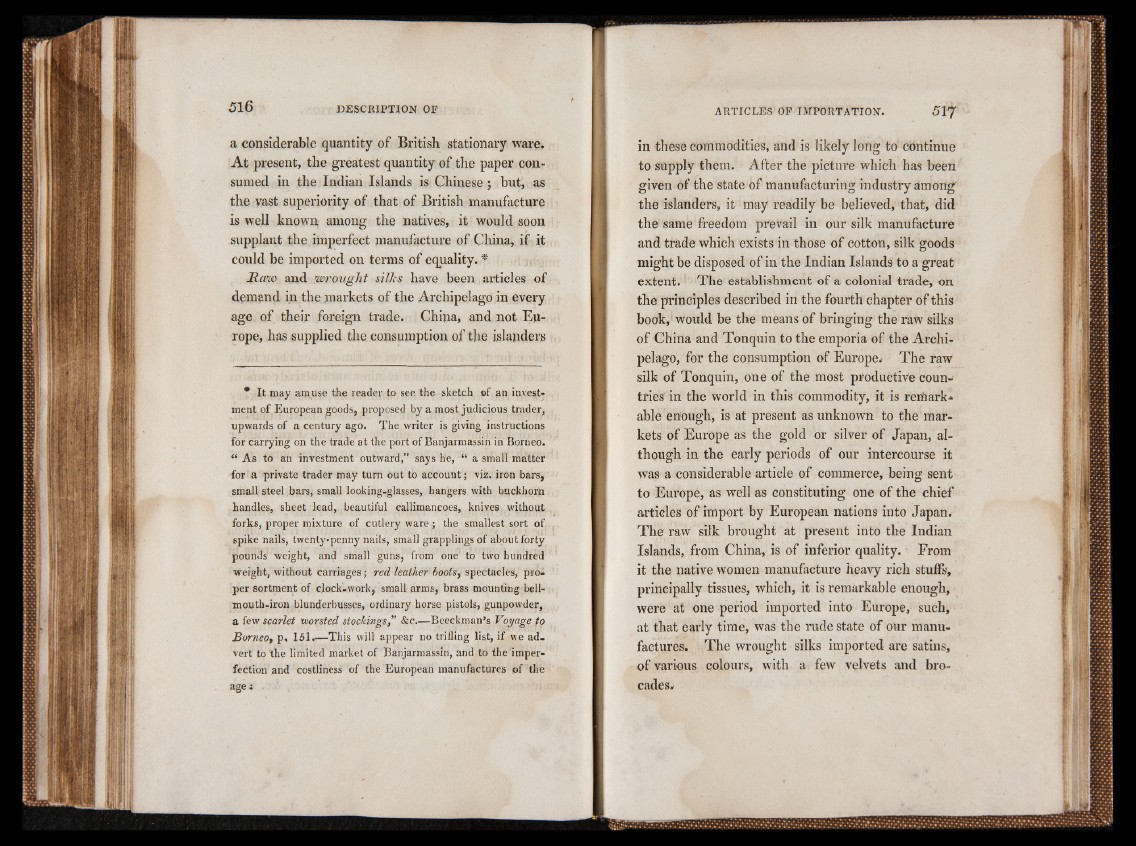
a considerable quantity of British stationary ware.
A t present, the greatest quantity of the paper consumed
in the Indian Islands is Chinese ; but, as
the vast superiority of that of British manufacture
is well known among the natives, it would soon
supplant the imperfect manufacture of China, if it
could be imported on terms of equality. *
Raw and ¿wrought silks have been articles of
demand in the markets of the Archipelago in every
age of their foreign trade. China, and not Europe,
has supplied the consumption of the islanders
* It may amuse the reader to see the sketch of an investment
of European goods, proposed by a most judicious trader,
upwards of a century ago. The writer is giving instructions
for carrying on the trade at the port of Banjarmassin in Borneo.
“ As to an investment outward,” says h'e, “ a small matter
for a private trader may turn out to account; viz. iron bars,
small steel bars, small looking-glasses, hangers with buckhom
handles, sheet lead, beautiful callimancoes, knives without
forks, proper mixture of cutlery ware ; the smallest sort of
spike nails, twentypenny nails, small grapplings of about forty
pounds weight, and small guns, from one' to two hundred
weight, without carriages; red leather boots, spectacles, proper
sortment of clock-work, small arms, brass mounting bell-
mouth-iron blunderbusses, ordinary horse pistols, gunpowder,
a few scarlet worsted stockings,” &c.—Beeckman’s Voyage to
Borneo, p. 151.—This will appear no trifling list, if we advert
to the limited market of Banjarmassin, and to the imperfection
and costliness of the European manufactures of the
age i .
in these commodities, and is likely long to continue
to supply them. After the picture which has been
given of the state of manufacturing industry among
the islanders, it may readily be believed, that, did
the same freedom prevail in our silk manufacture
and trade which exists in those of cotton, silk goods
might be disposed of in the Indian Islands to a great
extent. The establishment of a colonial trade, on
the principles described in the fourth chapter of this
book, would be the means of bringing the raw silks
of China and Tonquin to the emporia of the Archipelago,
for the consumption of Europe* The raw
silk of Tonquin, one of the most productive countries
in the world in this commodity, it is remark*-
able enough, is at present as unknown to the markets
of Europe as the gold or silver of Japan, although
in the early periods of our intercourse it
was a considerable article of commerce, being sent
to Europe, as well as constituting one of the chief
articles of import by European nations into Japan.
The raw silk brought at present into the Indian
Islands, from China, is of inferior quality. From
it the native women manufacture heavy rich stuffs,
principally tissues, which, it is remarkable enough,
were at one period imported into Europe, such,
at that early time, was the rude state of our manufactures*
The wrought silks imported are satins,
of various colours, with a few velvets and brocades.